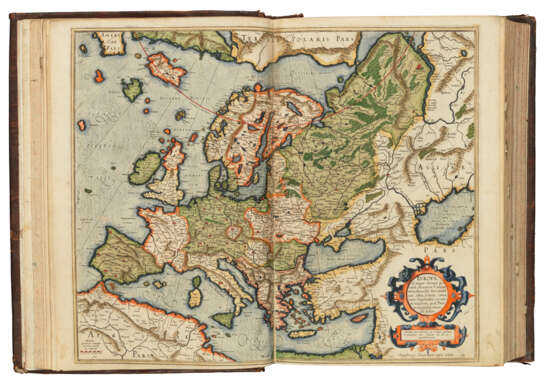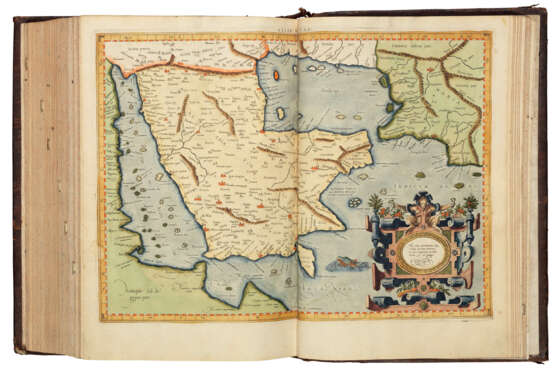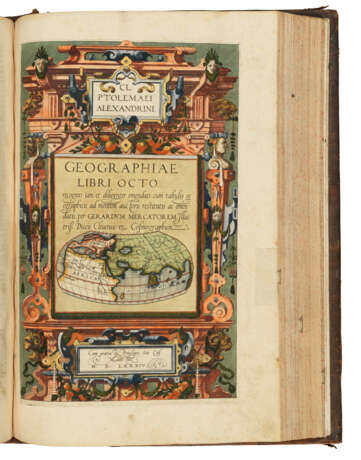ID 870686
Lot 128 | MERCATOR, Gerard (1512-1594)
Valeur estimée
£ 300 000 – 500 000
Atlas sive cosmographicae meditationes de fabrica mundi et fabricati figura. [Edited by Rumold Mercator (1545-1599).] Duisburg and Düsseldorf: Albert Buys for the author's heirs, 1585-1595. [Bound with:] PTOLEMAEUS, Claudius (c.100-c.178). Geographiae libri octo. [Edited by Gerard Mercator and Arnold Mylius (1540-1604).] Cologne: Gottfried von Kempen, 1584.
· First complete edition of the first truly modern scientific atlas
· Produced by the most influential geographer since Classical Antiquity
· The title of this book is first use of the name Atlas for a collection of maps
· Very fine condition, with beautiful contemporary hand-colouring
The atlas is composed of the individual parts relating to France, the Low Countries, Germany, Italy, the Balkans and Greece that were published separately between 1585 and 1594. After Gerard’s death, his son, Rumold, completed the atlas by adding the introduction describing the creation of the world, and the section containing Rumold’s famous double-hemisphere world map, the four continents, and maps of the British Isles, North Pole, Iceland, Scandinavia, Prussia, Russia, the Baltic countries, Transylvania, and Ukraine. This conforms to Van der Krogt’s 1:011A, i.e. the Atlas is made up from old stock, with the parts Gallia, Belgium inferior and Germania conforming to Van der Krogt 1:001 (collation 4, Acba), 1:002 Italia in B variant, and completed by Rumold’s fifth part composed of two books in Van der Krogt’s variant C. VD16 K2334; PMM 100; Shirley, BL T.MER-2c; Van der Krogt 1:011A; cf. BM/STC, German Books 619 (names only three parts); cf. Adams M 1298f (only two items).
The atlas is complemented by having the second edition of Gerard Mercator’s edition of Ptolemy's Geography, complete with all 28 maps finely coloured, bound at the end. Mercator was named by Ortelius as 'the Ptolemy of our time', and engraved these copperplates as part of a cosmography which he planned to publish in five volumes. In the event, the Ptolemaic maps published here, and the four parts of the section of modern maps, were the only works Mercator published before he died in 1594. This edition is the first with the translation by Willibald Pirckheimer. ‘When Mercator's Ptolemaeus atlas was reprinted in 1584, this time with texts on verso, this text closely resembles the texts of Ortelius' Nomencalator Ptolemaicus. Mylius dedicates this second edition of Mercator's Ptolemy to Ortelius to express his gratitude and that of Mercator for Ortelius' help’ (M. van den Broecke in: A World of Innovation. Cartography in the Time of Gerhard Mercator, p.172). VD16, P5219; Adams P 2232; BM/STC German Books 719; Sabin 66491; Shirley BL TPTOL-11c; Van der Krogt I, 1:502.
6 parts in one volume, folio (402 x 280mm). Fifth part bound first as usual, comprising 2 books, in Van der Krogt’s variant C:
Book I: π2 (engraved architectural and emblematic title in Van der Krogt state 1:10.2 with monogram added to plinth, bottom right; the title mounted on a stub with fore-edge slightly proud of textblock, but with areas of minor worming confined mostly to fore-edge margin and extreme lower-left consistent with following leaves and extending through to a1; letterpress dedication to Wilhelm and Johann Wilhelm, Dukes of Jülich, in first state, with author's portrait and verse caption by Bernard Furmer on verso, ) +4 ?2 (biography and epitaphs of the author, letters and verse in praise of the atlas, errata); a-d4 (text).
Book II: e2 (engraved architectural and emblematic title with letterpress printed overslip Atlantis Pars altera. Geographia nova Totius Mundi [as per van der Krogt 1:51.1], letterpress dedication to Queen Elizabeth signed e2, address to the reader Amico Lectori misbound before title), A-E2 (engraved maps of the world and the four continents), I-XVIII2 (maps of the North Pole, Iceland, Scotland, Ireland, England), XVIII.21 (dedication to Heinrich Rantzau), XVIIII2 (Norway and Sweden), XXa2 (description of Denmark), XXb-XXIX2 (maps of Denmark, Prussia, Russia, the Baltic countries, Transylvania and Ukraine), ?4 (letterpress index and colophon).
Part I (i.e. bound 3rd), France, Van der Krogt’s variant Ac: +6 (engraved title of Renaissance ornament Galliae tabulae geographicae [Van der Krogt 1:01.1], letterpress preliminaries), a-d2 c1 f-q2 (maps of France and Switzerland, map of Boulongne comitatus single-page), **j2 (index).
Part II (i.e. bound 4th), the Low Countries, Van der Krogt’s variant Ab: +4 (engraved title Belgii inferioris Geographicae tabulae [Van der Krogt 1:02.1], letterpress preliminaries, second leaf blank), r-z2 &2 ct2 (maps of the Low Countries and Luxemburg), +2 (index).
Part III (i.e. bound 5th), Germany, Van der Krogt’s variant Aa: ++4 (engraved title Germaniae tabulae geographicae [Van der Krogt 1:03.1], letterpress preliminaries, second leaf blank), A-F2 Fij2 G-Q2 Qij2 R-Z2 AA2 (maps of Germany, Bohemia, Moravia, Austria, Poland and Hungary), +++4 (index).
Part IV (i.e. bound 6th), Italy, the Balkans and Greece, Van der Krogt’s variant B: π2 (engraved title Italiae, Sclavoniae, et Graeciae tabulae geographicae [Van der Krogt 1:04.1], letterpress dedication to Ferdinando de' Medici), 1-222 (maps of Italy, the Balkans and Greece), a-c2 (index).
A total of 107 copperplate engraved maps, all but one, Boulongne comitatus, double-page on full sheets, all finely coloured by a contemporary hand, many with letterpress text on the versoes; woodcut initials and typographical ornaments.
[Bound with:] PTOLEMAEUS, Claudius (c.100-c.178). Geographiae libri octo. Cologne: Gottfried von Kempen, 1584. π2 (engraved ornamental title-page incorporating a Ptolemaic world map [Van der Krogt 1:52], letterpress dedication to Abraham Ortelius), A-I6 (letterpress text of Geographicae enarrationis), K-L6 M4 (index, final leaf blank), (?)4 (Tabulae Geographicae letterpress title, dedication and preface), A-M2 M22 O2 ?1 N-Bb2 (Asiae tabula X misbound after Asiae tabula XII ), a-b6 c3 (index, lacking final blank c4). 28 Ptolemaic maps, complete with the additional single-page map, all finely coloured by a contemporary hand; woodcut initials, diagrams and typographical ornaments.
Late 17th-/early 18th-century calf, gilt spine in seven compartments with raised bands, morocco gilt label in second compartment, speckled edges (extremities rubbed and scraped, with headcap splitting and almost detached, upper joint splitting at foot, but the whole sound). Provenance: small circular stamp removed from head of dedication leaf and repaired with small old paper patch – partially erased illegible inscription in an early hand at foot of dedication with some associated paper loss (not affecting any letters) and associated staining to verso – Graf Leopold Franz Maria von Thurn-Valsassina und Taxis (1688-1750; ownership inscription on front pastedown dated ‘1725 et 1737’ with note in the same hand at the bottom of the pastedown referring to cost price, ‘pretio vid: Mis. 110 et 165’).
Special Notice
No VAT on hammer price or buyer's premium.
| Lieu d'origine: | Europe de l'Ouest, Allemagne, Europe |
|---|---|
| Catégorie maison de vente aux enchères: | Cartes et Atlas |
| Lieu d'origine: | Europe de l'Ouest, Allemagne, Europe |
|---|---|
| Catégorie maison de vente aux enchères: | Cartes et Atlas |
| Adresse de l'enchère |
CHRISTIE'S 8 King Street, St. James's SW1Y 6QT London Royaume-Uni | |
|---|---|---|
| Aperçu |
| |
| Téléphone | +44 (0)20 7839 9060 | |
| Commission | see on Website | |
| Conditions d'utilisation | Conditions d'utilisation |


















